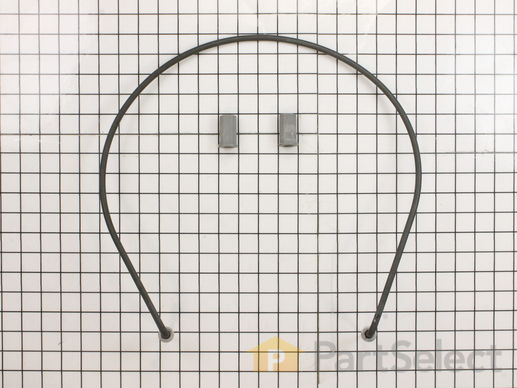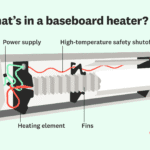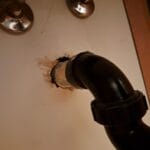To test a dishwasher heating element, use a multimeter set to the ohms setting and check for continuity. Ensure the dishwasher is unplugged before starting.
Dishwashers play a crucial role in modern kitchens, keeping our dishes clean and hygienic. The heating element inside is key for drying dishes efficiently. Over time, this component might fail, leading to cold, wet dishes at the end of a cycle.
Recognizing the signs of a faulty heating element is the first step towards a solution. Testing it is a straightforward task requiring minimal tools. This guide provides a quick and effective method to check if your dishwasher’s heating element is working properly. Understanding how to perform this test can save time and money, potentially avoiding the need for professional repairs. Remember, safety first: always disconnect the dishwasher from its power source before attempting any checks or repairs.

Credit: partselect.com
Introduction To Dishwasher Heating Elements
Dishwashers need heating elements to work properly. These parts heat water and dry dishes. Over time, they can break down. Knowing how they work and when they fail is key.
The Role Of Heating Elements
Heating elements are crucial in dishwashers. They perform two main tasks:
- Raise water temperature for cleaning dishes.
- Dry dishes after washing.
These elements ensure your dishes come out clean and dry.
Signs Of Malfunction
Look out for these signs:
- Dishes remain wet or have spots.
- Water doesn’t get hot.
- Visible damage to the element.
Spotting these early helps prevent bigger issues
Safety First: Preparing For The Test
Before diving into any appliance repair, safety is paramount. Testing a dishwasher’s heating element is no exception. It’s a simple process if you follow the right steps. Let’s prepare with the necessary tools and precautions to ensure a safe and successful test.
Tools You’ll Need
Gathering the right tools is the first step. Here’s what you’ll need:
- Voltmeter to check electrical continuity
- Screwdriver for accessing the element
- Work gloves to protect your hands
- Eye protection to keep your eyes safe
Safety Precautions
Adhere to these safety tips to avoid any hazards:
- Turn off power to the dishwasher at the breaker box.
- Check that the power is indeed off with a non-contact voltage tester.
- Wear gloves and eye protection at all times.
- Ensure the dishwasher is empty and cool.
- Keep water away from electrical components during the test.
Accessing The Heating Element
Is your dishwasher not heating water as it should? The heating element could be at fault. This vital component warms the water for effective cleaning. To test or replace it, first, access the heating element.
Locating The Element
The heating element is at the dishwasher’s base. It looks like a thin, circular tube. Turn off the power before you start. Safety first!
Removing Obstacles
Before reaching the element, remove the bottom rack. Unscrew the element if screws are present. Take notes or photos to remember the steps.
- Turn off the dishwasher and unplug it.
- Remove the bottom dish rack for space.
- Unscrew the heating element using a screwdriver.
- Keep screws and parts in a container.
Visual Inspection
Visual inspection is a crucial first step in testing a dishwasher’s heating element. It can reveal issues not immediately obvious. Simple visual cues can guide homeowners or technicians to decide the next course of action. Let’s dive into how to identify any visible damage and understand when it’s time for a repair or a full replacement of the heating element.
Identifying Visible Damage
Start by disconnecting power to the dishwasher for safety. Remove the bottom rack to access the heating element. Look for signs of wear or damage. These may include:
- Cracks in the element surface.
- Blistering or deformations.
- Areas with burn marks or discoloration.
Visible damage often suggests a faulty element. It may need replacement to ensure your dishwasher functions properly.
When To Replace Vs. Repair
If damage is evident, a replacement is usually the best option. Elements with minor issues sometimes get repaired, but this is rare. Consider these factors:
| Condition | Action |
|---|---|
| Severe damage | Replace |
| Minor wear | Monitor or consult a professional |
Always prioritize safety and efficiency. A new element ensures optimal performance and avoids potential hazards.
Conducting The Continuity Test
A dishwasher’s heating element is crucial for drying dishes. Testing it ensures it functions properly. A continuity test is a simple method. It checks for electrical flow through the heating element. Here’s how you can perform this important test.
Setting Up Your Multimeter
- Ensure safety: Unplug the dishwasher to avoid electric shock.
- Select tool: Use a multimeter, also called a multitester.
- Set function: Turn the dial to the continuity setting.
- Prepare leads: Insert the test leads into the correct jacks.
Before starting, confirm the multimeter works. Touch the leads together. The device should beep or show zero resistance.
Interpreting Results
Now, test the heating element. Place one lead on each terminal. A good element shows low resistance. The multimeter will beep, indicating continuity. No beep or infinite resistance suggests a problem. Replace the element if the test fails. This ensures your dishwasher runs effectively.
Remember, a broken heating element can lead to poor performance. Regular checks keep your dishwasher in top shape. This guide helps you test effectively and safely.

Credit: youtube.com
Additional Tests For Comprehensive Assessment
When a dishwasher stops heating water, it’s often the heating element at fault. A thorough assessment includes additional tests beyond visual inspections. These ensure the heating element functions properly. Let’s dive into these essential checks.
Resistance Check
Testing the resistance of a dishwasher’s heating element is crucial. A multimeter helps in this test. You look for a specific resistance value. This value is typically between 10 to 50 ohms. Here’s how:
- Turn off the dishwasher.
- Disconnect the heating element.
- Set the multimeter to ohms.
- Place each probe on the element’s terminals.
- Read the multimeter. A value within range means the element is good.
A resistance outside this range suggests a problem. Replace the element if the resistance is off.
Testing For Ground Faults
Ground faults indicate a safety hazard. They mean the element could be leaking current. Here’s how to test for these faults:
- Keep the dishwasher off.
- Keep one probe on the element terminal.
- Touch the other probe to the metal case.
- A reading other than infinity means a fault is present.
- Replace the element if a ground fault is detected.
These tests are simple yet vital for dishwasher safety and functionality. They help to avoid further damage and costly repairs. Remember to always prioritize safety and consult a professional if in doubt.
Interpreting Test Outcomes
Interpreting Test Outcomes of a dishwasher’s heating element tells you its health. A working element heats water efficiently. A faulty one leads to lukewarm or cold cycles. Knowing how to read test results can save you from unexpected cold washes and high repair bills.
When To Call A Professional
After testing, certain signs indicate the need for an expert. These include:
- Inconsistent readings: Fluctuating resistance values suggest complex issues.
- Visible damage: Cracks or burns on the element require professional attention.
- No continuity: A multimeter shows no reading, indicating a break in the circuit.
Professionals handle complex diagnostics and repairs safely. They ensure your appliance operates efficiently.
Diy Repair Tips
For confident homeowners, some issues can be fixed at home. Here are simple tips:
- Power off: Always disconnect the dishwasher before attempting repairs.
- Check connections: Loose wiring can mimic a faulty element.
- Replace element: If tests confirm a failed element, installing a new one can be straightforward.
Remember, safety comes first. Wear protective gear and follow the manufacturer’s guide.
Maintaining Your Dishwasher’s Heating Element
A dishwasher’s heating element is crucial. It dries dishes efficiently. Without proper care, it may fail. Learn to maintain it here.
Regular Cleaning Tips
Clean regularly to prevent buildup. Follow these steps:
- Unplug the dishwasher for safety.
- Remove the bottom rack to access the element.
- Use a soft cloth and mild detergent to wipe the element.
- Rinse with water and dry thoroughly.
Preventive Measures
Prevent issues before they happen. Use these tips:
| Tip | Benefit |
|---|---|
| Check for objects | Prevents damage to the element |
| Run hot water | Enhances cleaning performance |
| Avoid harsh chemicals | Protects element integrity |
Frequently Asked Questions
How Do I Know If The Heating Element In My Dishwasher Is Bad?
To determine if your dishwasher’s heating element is faulty, check for visible signs of damage or corrosion. Also, dishes may not dry completely, indicating a malfunction. For a precise diagnosis, use a multimeter to test the element’s continuity.
What Is The Resistance Of A Dishwasher Heating Element?
The resistance of a dishwasher heating element typically ranges from 10 to 50 ohms, varying by model and manufacturer.
How To Test A Heating Element With A Multimeter?
To test a heating element with a multimeter, first, turn off the power. Next, disconnect the element and set your multimeter to the ohms setting. Touch the probes to the element terminals. A reading indicates a functional element; no reading suggests it needs replacing.
Is It Worth Replacing The Heating Element In A Dishwasher?
Yes, replacing the heating element in a dishwasher is worthwhile. It restores optimal function, enhances drying performance, and is cost-effective compared to buying a new appliance. Always ensure a professional assesses the issue to confirm this is the necessary repair.
How Does A Dishwasher Heat Water?
Dishwashers typically use a built-in heating element at the bottom of the unit to warm water during various wash and rinse cycles.
Conclusion
Testing your dishwasher’s heating element ensures your appliance performs efficiently. Quick troubleshooting can save time and avoid costly repairs. Remember, safety first – disconnect power before you begin. For optimal performance, regularly maintain your dishwasher. Need professional help? Don’t hesitate to call a technician.
Keep your dishwasher in top shape!




